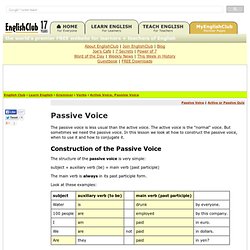

The Passive Voice in English 2 (Mixed tenses) AddThis Sharing Buttons Share to EmailShare to Favorites ONLINE ENGLISH GRAMMAR QUIZ topic: THE PASSIVE VOICE 2 (Mixed tenses) | level: Intermediate The first sentence is in the ACTIVE VOICE.

Choose the most correct way of saying the same thing in the PASSIVE VOICE: 1. They were interviewing her for the job. Back to list of exercises OUR OTHER WEBSITES:EnglishLiteracySite.com (ENGLISH)BusinessEnglishSite.com (ENGLISH)ESLPDF.com (ENGLISH)EnglishForMyJob.com (ENGLISH)Infosquares.com (ENGLISH)LearnSpanishFeelGood.com (SPANISH)LearnPolishFeelGood.com (POLISH) OTHER ESL WEBSITES / ADVERTISE WITH US / LINK TO US / ABOUT US / CONTACT US (c) 2006-2018 LearnEnglishFeelGood.com unless otherwise stated. Quiz VII. Present Simple Passive vs Present Continuous Passive I. Passive azar. Recognizing Passive Voice. Active to passive exercise from web. Passive voice, passive tense & causative verbs in English worksheets for ESL teachers: eslflow webguide. The Passive Voice in English 2 (Mixed tenses) Active vs Passive Voice. Passive Voice. The passive voice is less usual than the active voice.

The active voice is the "normal" voice. But sometimes we need the passive voice. In this lesson we look at how to construct the passive voice, when to use it and how to conjugate it. Construction of the Passive Voice The structure of the passive voice is very simple: subject + auxiliary verb (be) + main verb (past participle) The main verb is always in its past participle form.
Look at these examples: Use of the Passive Voice We use the passive when: we want to make the active object more importantwe do not know the active subject Note that we always use by to introduce the passive object (Fish are eaten by cats). Look at this sentence: He was killed with a gun. Conjugation for the Passive Voice We can form the passive in any tense.
Present simple: It is madepresent continuous: It is being madepresent perfect: It has been made Here are some examples with most of the possible tenses: Now check your understanding » Passive Voice - Learning English - Grammar Exercises. Active vs. Passive Voice Basketball Game. ESL Interactive Fun Games Here we have the games carefully laid out for you.

Follow the links to browse the variety of games offered. This is only the directory for interactive games and exercises. Our ESL fun games here include : Snakes and Ladders, Hangman, Spelling games, Wheel of Fortune, TV Games(Betting Game), Mazes, Memory Games, Matching exercises, Sequencing exercises, Picture Quizzes, Catch it and more. These games provide the ultimate fun in practising the following skills: Grammar Games & Interactive Exercises - Click Here! Games for Practising Grammar: Present simple/present progressive games, past tense games, present perfect games, comparative/Superlatives and more... Vocabulary Games & Interactive Exercises - Click Here! Games for practising English vocabulary: Lots of games by topics and game types Pronunciation Games & Interactive Exercises - Click Here!
Games to practice English pronunciation, phonetics and phonics. An English-Zone.Com Chart: Active and Passive Voice. Active / Passive Exercise. Learn English - Passive Voice. Exercises on Passive Use of Passive Passive voice is used when the focus is on the action.

It is not important or not known, however, who or what is performing the action. Example: My bike was stolen. In the example above, the focus is on the fact that my bike was stolen. Sometimes a statement in passive is more polite than active voice, as the following example shows: Example: A mistake was made. In this case, I focus on the fact that a mistake was made, but I do not blame anyone (e.g. Form of Passive Subject + finite form of to be + Past Participle (3rd column of irregular verbs) Example: A letter was written. When rewriting active sentences in passive voice, note the following: the object of the active sentence becomes the subject of the passive sentence the finite form of the verb is changed (to be + past participle) the subject of the active sentence becomes the object of the passive sentence (or is dropped)